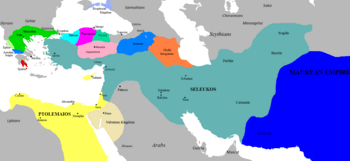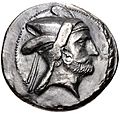Seleucid Empire facts for kids
Quick facts for kids
Seleucid Empire
|
|||||||||||||||||||
|---|---|---|---|---|---|---|---|---|---|---|---|---|---|---|---|---|---|---|---|
| 312 BC–63 BC | |||||||||||||||||||
|
Tetradrachm of Seleucus I, the horned horse, the Elephant and the anchor were all used as symbols of the Seleucid monarchy.
|
|||||||||||||||||||

The empire at its greatest extent and on the eve of the death of Seleucus I, 281 BC
|
|||||||||||||||||||
| Capital | Seleucia (305–240 BC) Antioch (240–63 BC) |
||||||||||||||||||
| Common languages | Greek(official) Persian Aramaic |
||||||||||||||||||
| Religion | Olympianism Babylonian religion Zoroastrianism |
||||||||||||||||||
| Government | Monarchy | ||||||||||||||||||
| Basileus | |||||||||||||||||||
|
• 305–281 BC
|
Seleucus I (first) | ||||||||||||||||||
|
• 65–63 BC
|
Philip II (last) | ||||||||||||||||||
| Historical era | Hellenistic period | ||||||||||||||||||
| 312 BC | |||||||||||||||||||
|
• Battle of Ipsus
|
301 BC | ||||||||||||||||||
| 192–188 BC | |||||||||||||||||||
|
• Treaty of Apamea
|
188 BC | ||||||||||||||||||
| 167–160 BC | |||||||||||||||||||
| 63 BC | |||||||||||||||||||
| Area | |||||||||||||||||||
| 301 BC | 3,000,000 km2 (1,200,000 sq mi) | ||||||||||||||||||
| 240 BC | 2,600,000 km2 (1,000,000 sq mi) | ||||||||||||||||||
| 175 BC | 800,000 km2 (310,000 sq mi) | ||||||||||||||||||
| 100 BC | 100,000 km2 (39,000 sq mi) | ||||||||||||||||||
|
|||||||||||||||||||
| Today part of | |||||||||||||||||||
The Seleucid Empire was a powerful kingdom that came after the huge empire of Alexander the Great. It was part of the Hellenistic period, which means it had a strong Greek influence. At its largest, the empire stretched across a vast area. This included parts of modern-day Turkey, the Middle East, Mesopotamia, Iran, Turkmenistan, and even parts of Pakistan.
This empire mostly took over from the Achaemenid Empire of Persia. Later, much of this land became part of big Islamic empires, like the Caliphates, starting around 650 AD.
The Seleucid dynasty had over 30 kings. They ruled from 323 BC until 63 BC.
Contents
How Alexander's Empire Was Divided
Alexander the Great had conquered the massive Persian Empire. But he died young, leaving his huge empire without a clear adult heir. His empire was a mix of Greek and local cultures.
In 323 BC, a general named Perdiccas became the regent (someone who rules for a king who is too young or absent). Alexander's generals, called satraps, divided the lands among themselves at the Partition of Babylon. Soon, these generals started fighting each other to gain more power and land. This led to many wars between the different parts of the empire.
The Rise of the Seleucid Empire
Seleucus I was one of Alexander's generals. He received a large part of the empire. His lands included Syria, Babylon, parts of Turkey, and even lands stretching towards India. When Perdiccas was killed, Alexander's empire completely broke apart.
The Seleucid Empire quickly grew. It expanded into parts of Thrace in the west and beyond the Indus River in the east. Seleucus I often fought with the Ptolemaic Dynasty from Egypt. The Ptolemies controlled Egypt and nearby areas. They frequently battled the Seleucids for control of Syria.
Seleucus I conquered much of Anatolia. He was planning to invade Macedonia when he was assassinated. This stopped the Seleucid Empire's plans to expand into Greece for a while. After Seleucus I died, his successors worked hard to keep control of the enormous empire. They were quite successful, but the empire was so vast that it was hard to manage effectively.
Images for kids
-
Coin of Seleucus I Nicator
-
In Bactria, the satrap Diodotus asserted independence to form the Greco-Bactrian kingdom c. 245 BC.
-
Silver coin of Antiochus III the Great.
-
The reduced empire (titled: Syria, Kingdom of the Seleucids) and the expanded states of Pergamum and Rhodes, after the defeat of Antiochus III by Rome. Circa 188 BC.
-
Coin of Antiochus IV Epiphanes.
See also
 In Spanish: Imperio seléucida para niños
In Spanish: Imperio seléucida para niños













